Digital Poster
Stroke: Carotid Plaque & Ischemic Stroke
ISMRM & ISMRT Annual Meeting & Exhibition • 10-15 May 2025 • Honolulu, Hawai'i

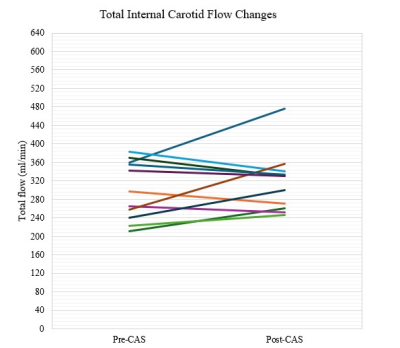 |
Computer Number: 97
2357. Evaluation
of the impact of carotid artery stenting on blood flow in
carotid disease – a prospective follow-up MRI study
R. Kaur, P. Summers, W. Siu, X. Song
Simon Fraser University, Burnaby, Canada
Impact: Our findings suggest carotid artery stenting
maintains or increases overall carotid blood flow,
potentially benefiting functional recovery.
|
|
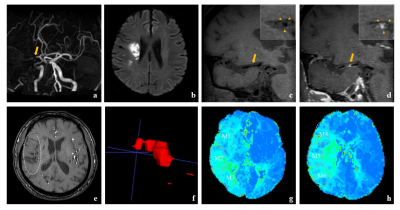 |
Computer Number: 98
2358. Combination
of Culprit Plaque Enhancement Ratio and Hypoperfusion
Contributes to Outcomes of Patients with Middle Cerebral Artery
Stenosis
S-S Wu, L. Wang, J-W Yu, Y. Wu, X-C Zhao, D-L Zhao
Department of Radiology, Zhongda Hospital, Medical School, Southeast University, Nanjing, China
Impact: Our study included more factors related to the
outcome of ischemic stroke and improved the accuracy in
predicting the 90-day functional outcome of patients with
ischemic stroke. This improvement can inform the planning of
future clinical interventions.
|
|
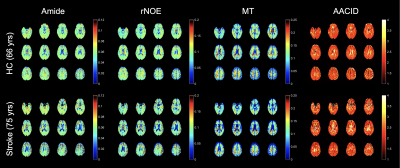 |
Computer Number: 99
2359. Assessment
of molecular and pH-weighted signal changes in chronic ischemic
stroke using CEST MRI at 3T
J. Huang, M. Y. M. Chan, Y. Zhang, G. K. K. Lau, K. W. Y.
Chan
The University of Hong Kong, Hong Kong, China
Impact: Chronic ischemic stroke brains exhibited
decreased amide, rNOE, and MT signals, indicating reductions
in proteins and lipids, along with an increased AACID signal
suggesting a lower pH level. CEST MRI can monitor the
prognosis of ischemic stroke in clinical settings.
|
|
 |
Computer Number: 100
2360. The
utility of 4D Flow MRI blood flow analysis in patients with
cervical carotid artery stenosis
T. Ando, T. Sekine, K. Iwata, M. Nakaza, K. Suzuki, Y.
Murai, S. Kumita
Nippon Medical School, Sendagi, Japan
Impact: In cases of carotid artery stenosis, TKE
measured by 4D Flow MRI may serve as a parameter for
characterizing the pathology of carotid artery stenosis and
risk stratification.
|
|
 |
Computer Number: 101
2361. Risk
Factors for Co-existing Extracranial Carotid and Intracranial
Artery High-Risk Atherosclerotic Plaques: A MR Imaging Study
X. Chen, D. Yang, X. Song, S. Chen, H. Qiao, C. Yuan, Z.
Zheng, X. Zhao
Beijing Tsinghua Changgung Hospital, School of Clinical Medicine, Tsinghua University, Beijing, China
Impact: To identify the risk factors for co-existing
extracranial carotid and intracranial artery HRPs is
valuable for precision management and prevention of future
adverse events.
|
|
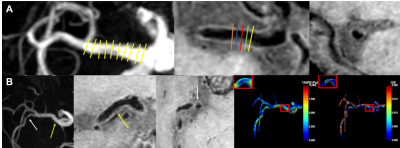 |
Computer Number: 102
2362. Anatomical
location related hemodynamic variations are associated with MCA
atherosclerosis: a preliminary 4D flow and 3D vessel wall MRI
study
P. Jiang, L. Liu, H. Qiao, X. Xu, Y. Zheng, L. Lin, J. Chen,
B. Sun, H. Wang, X. Zhao, Z. Chen, Y. Xue
Fujian Medical University Union Hospital, Fuzhou, China
Impact: Arterial segment, plaque number and plaque
characteristics may have a significant interplay with the
local hemodynamic environment, which could provide insight
for atherosclerotic development.
|
|
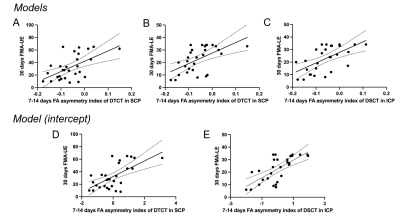 |
Computer Number: 103
2363. Assessing
the Predictive Impact of Corticocerebellar Pathway Integrity on
Stroke Motor Outcomes
J. Liu, y. Shan, B-x Cui, S-z Yan, L-l Ye, B-y Xu, L. Cao,
M. Zhang, J. Lu
Xuanwu Hospital, Capital Medical University, Beijing, China
Impact: Our study highlights the importance of
corticocerebellar pathway integrity in predicting motor
recovery after stroke. These insights can enhance early
prognosis and guide personalized rehabilitation strategies
for patients with middle cerebral artery infarction.
|
|
 |
Computer Number: 104
2364. Evaluation
of Middle Cerebral Artery Vessel Wall in Anterior Circulation
Transient Ischemic Attack: A 5.0 T MRI and 3D High-Resolution
Study
L. Yin, j. wang, Z. Li, d. yu, j. gan
Shandong Provincial Third Hospital, Jinan, China
Impact: This
study demonstrates that 5.0 T MRI with high-resolution
3D-VWI can reliably identify high-risk structural changes in
TIA patients, enhancing early stroke risk assessment and
potentially guiding personalized intervention strategies for
improved patient outcomes.
|
|
 |
Computer Number: 105
2365. A
Longitudinal Study of T2 Mapping and DTI to Quantitatively
Evaluate Neuroprotective Effect of rTMS on Ischemic Rat Brain
Q. Zhang, A. Saeed, X. Tang, H. Shao, W. Liu, S. Huang, C.
Liu, F. Guo, L. Peng, W. Zhu
Tongji Hospital, Tongji Medical College, Huazhong University of Science and Technology, wuhan, China
Impact: Parameters derived from T2 mapping and DTI can
be used together as imaging biomarkers to assess the
neuroprotective effect of rTMS on ischemic stroke. The
longitudinal quantitative MRI evaluation provided new
insights into the rTMS treatment for acute ischemic stroke.
|
|
|
Computer Number: 106
2366. Carotid
Plaque Characteristics Predict Progression of White Matter
Hyperintensities: A Prospective PET/MR Imaging Study
S. Zhang, M. Feng, S. Yan, J. Lu
Xuanwu Hospital Capital Medical University, Beijing, China
Impact: By identifying carotid plaque features that
predict WMH progression, this study enables early
identification of high-risk patients, guiding targeted
interventions to prevent cerebral vessel disease progression
and cognitive decline in those with carotid artery stenosis.
|
||
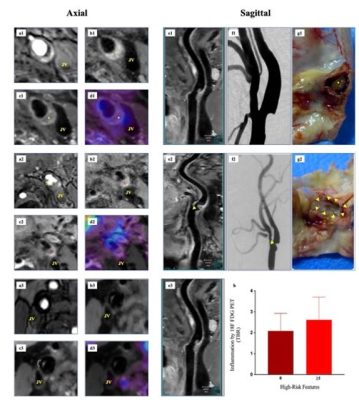 |
Computer Number: 107
2367. Quantitative
assessment of carotid plaques vulnerability based on
neovascularization and macrophage inflammation by hybrid PET/MR
Y. Zhang, J. Lu
Xuanwu Hospital Capital Medical University, Beijing, China
Impact: Reveal the vulnerable characteristics of
neovascularization and inflammation within plaques,
elucidate the correlation between the two and the
pathophysiological mechanisms of plaque vulnerability,
achieve early imaging warning, and effectively prevente the
occurrence of ischemic stroke.
|
|
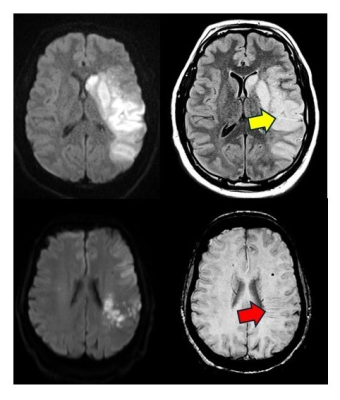 |
Computer Number: 108
2368. Post
Treatment MRI Markers of Collateral Status Related to Adverse
Events and Outcomes in Large Vessel Occlusion Acute Ischemic
Stroke (LVO-AIS)
C. Greene, D. Lakhani, K. Chen, M. Kim, M. Hoseinyazdi, V.
Yedavalli
Johns Hopkins University, Baltimore, United States
Impact: Preliminarily we demonstrate a relationship
between FHVS and LVO-AIS complications and outcomes when
accounting for patient and imaging factors. Post treatment
MRI signs related to nuances in underlying tissue properties
may thus help inform further patient assessment and
treatment.
|
|
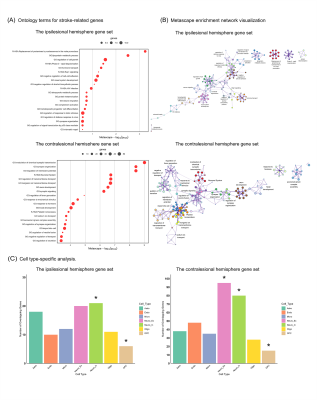 |
Computer Number: 109
2369. Molecular
basis of Gray Matter Volume Alterations in Ipsilesional and
Contralesional Hemispheres after Subcortical Stroke
T. Jin, H. Gao, W. Hong, R. Xu, Z. Liu, Y. Wu, D. Wu, Y. Ma,
Z. Zhao
Key Laboratory for Biomedical Engineering of Ministry of Education, Department of Biomedical Engineering, College of Biomedical Engineering & Instrument Science, Zhejiang University, Hangzhou, China
Impact: Our findings demonstrate that contralesional
increase and ipsilesional decrease in the GMV after stroke
were linked to different molecular pathways and cellular
types. These findings provide new insights into
understanding brain damage and compensatory mechanisms after
stroke.
|
|
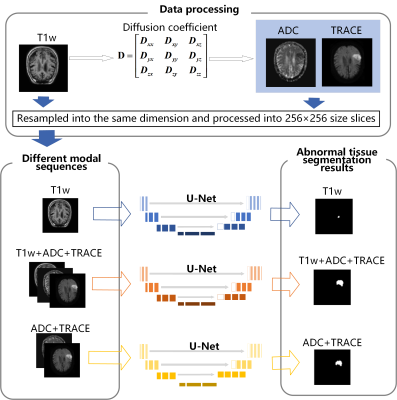 |
Computer Number: 110
2370. Lesion
detection in stroke patients based on intra-modality features on
Diffusion MRI
S. Cao, Y. He, T. Wang, J. Qin, Y. Wu
Nanjing University of Science and Technology, Nanjing, China
Impact: This study emphasizes the advantages of
diffusion sequences (ADC, TRACE) in detecting brain tissue
abnormalities while addressing the limitations of
single-modal models. It also presents a novel method for
developing multi-modal training models from a single
modality.
|
|
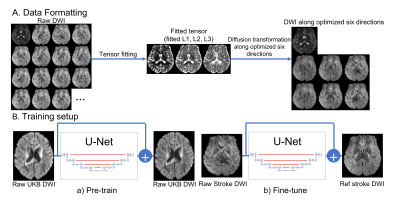 |
Computer Number: 111
2371. High-fidelity
Ultra-fast Diffusion Tensor Imaging in Stroke Patients Using
Transfer Learning
Y. Jing, Z. Li, Y. Yu, J. Zhou, Z. Li, J. Zheng, H. Yang, M.
Liu, W. Wu, Q. Tian, J. Lu
Tsinghua University, Beijing, China
Impact: Our work supports and promotes the feasibility
of deep learning approach to benefit the clinical adoption
of DTI for diagnosis and/or pre-surgical planning in
scenarios where the scan time is extremely limited (e.g.,
for stroke patients).
|
|
 |
Computer Number: 112
2372. The
Application of New Models WMTI and MAPL in Assessing White
Matter Microstructural Damage in Non-basal Ganglia Subcortical
Ischemic Stroke
H. Wan, H. Su, Y. Li, W. Zhu
Tongji Hospital, Tongji Medical College, Huazhong University of Science and Technology, Wuhan, China
Impact: Compared to traditional diffusion models DTI and
DKI, the novel diffusion model MAPL exhibits higher
sensitivity in describing changes in brain tissue
microstructure. Additionally, changes observed during
follow-up are positively correlated with NIHSS changes,
making it a potential biomarker for estimating brain injury
in ischemic stroke.
|
The International Society for Magnetic Resonance in Medicine is accredited by the Accreditation Council for Continuing Medical Education to provide continuing medical education for physicians.